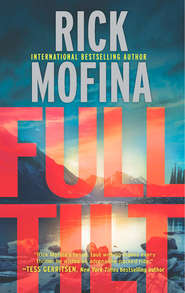По всем вопросам обращайтесь на: info@litportal.ru
(©) 2003-2024.
✖
Six Seconds
Автор
Год написания книги
2018
Настройки чтения
Размер шрифта
Высота строк
Поля
The guy from Tokyo was a seasoned news photographer, having covered some terrible stuff like wars and tsunamis. He was fairly calm, philosophical, Graham thought. It was a different story with the women, who were left shaken by their futile attempt to revive the boy. “That poor child. That poor, poor child.”
Static crackled from a police radio, pulling Graham’s attention to the man approaching. He’d emerged from the tangle of emergency vehicles atop the riverbank where members from the Banff and Canmore general investigations sections were with the witnesses. He stopped at the tape. A wise decision.
“Corporal Graham?”
Graham moved closer to the new arrival. He was in his midthirties. Maybe six feet tall, wearing jeans and a checkered shirt under a black leather bomber jacket.
“Owen Prell. Inspector Stotter sent me.”
“Got here pretty quick.” Graham shook his hand.
“I was already in Canmore.”
“Mike said you joined Major Crimes from Medicine Hat.”
“Worked GIS. They just set me up by your desk at the office. I’m looking forward to working with you.” Prell looked back to the patrol cars and uniformed officers. “The other members want to know if you’re done with the witnesses. The people would like to go.”
“We’re almost done with them.” Graham flipped his pages. “Get them to surrender their passports. We’ll run them through Interpol. Just say it’s procedure and we’ll return them soon.”
“Will do.”
As Prell turned, a helicopter throbbed overhead, skimming the river. The RCMP’s chopper out of Edmonton. The instant it disappeared, Graham heard his name. The FIS member processing the canoe was waving for him to come and see something.
Something important.
Wedged in the rocks where the canoe crashed was a small metal plate displaying the label Wolf Ridge Outfitters. The screw holes aligned with those on the canoe. It was a rental. Number 27.
Rental agencies kept records.
“Prell!”
The constable returned with his radio. An urgent request was made to the telecomms dispatcher to contact Wolf Ridge and cross-reference its rental agreement for Number 27 with the park’s permits and wilderness passes.
It took twenty minutes for the information to come back.
The canoe was rented by Ray Tarver, of Washington, D.C.
Park permits showed Ray, Anita, Tommy and Emily Tarver as the visitors registered to drive-in campsite #131.
6
Faust’s Fork, near Banff, Alberta, Canada
Campsite #131 was upstream, deep in the backcountry, secluded in a dense stand of spruce and pine, offering sweeping views of the river and the rugged cliffs of the Nine Bear Range.
When Graham arrived with the others, he saw no movement.
A late-model SUV was parked near a large dome tent. It was a typical campsite: propane camping stove, lawn chairs, four life jackets stacked neatly against a spruce tree, food kept a safe distance from the tent, and other items, including shirts and pants, hanging from a clothesline tied between two pine trees. Shouts for the Tarvers were answered by the river’s rush and the thud of the search helicopters.
The site was silent.
Lifeless.
Graham declared it a second scene and as Prell and the others taped it off and radioed for a request to run the SUV’s Alberta plate, he entered the tent alone.
Inside, he detected the pleasant fragrances of soap and sunscreen. There was also the sense that something had been interrupted but he couldn’t put his finger on it. Time had stopped here. To one side, was a sleeping bag big enough for two adults. Next to its left pillow, a Danielle Steel paperback. Next to the right, a large flashlight.
Across the tent, two smaller sleeping bags, side by side. A Sponge Bob comic was splayed open on one, while a pink stuffed bunny sat on the other, arms open, awaiting its owner’s return.
Graham picked it up, looked into its button eyes.
Children’s clothes in bright colors erupted from small backpacks: sweaters, small pants. The larger bags on the opposite side were also open, clothes spilled from them, but not in a disheveled way.
It was orderly.
Graham searched in vain for a purse or wallet. Campers often hid them or locked them away. After making notes, he stepped outside, where Prell updated him.
“The SUV’s a rental from an outlet at Calgary International. Customer’s Raymond Tarver, same D.C. address.”
“Anything inside?”
“It’s locked.”
“Get the rental agency to open it for us ASAP. Tell them it’s a police emergency. Then we’ll get forensics to process it and this site. Nobody tromps around here or touches anything.”
Graham nodded upriver.
“What about the people in the neighboring sites?”
“Some of the guys have started a canvas.”
“Good, I want statements, time lines, background checks.”
“Will do. Corporal, what do you suspect happened to the parents?”
“I don’t know.” Graham surveyed the site again: the life jackets, the cooler of food kept at a proper distance from the tent, a pail of dirt near the fire ring—did theycook hot dogs, toast marshmallows and huddle underthe stars together? Did they die together? “These people follow the rules, keep things safe, take no risks. I don’t know what happened.”
Later that night, after Prell had gone back to Calgary, Graham watched flashlights and headlamps probe the dark river valley as SARS teams continued searching. Graham was alone at his own campsite sitting before a fire, listening to transmissions echoing from the borrowed radio next to him.
As the searchers reported, Graham reviewed his case.
After a mechanic from the rental agency had opened the SUV, Prell found more items, including a wallet, a purse and U.S. passports belonging to the Tarvers. The flames illuminated the faces of Raymond, his wife, Anita, their son, Thomas, and their daughter, Emily, the girl who took her final breaths in Graham’s arms.
What went wrong here?
Graham wanted to believe that this was your nice, average American family. But where were Ray and Anita Tarver?
Did they drown their children?











